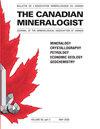Crystal Chemistry of Zemannite-Type Structures: III. Keystoneite, the Ni2+-Analogue of Zemannite, and Ferrotellurite Discredited
IF 1.5
4区 地球科学
Q3 MINERALOGY
引用次数: 3
Abstract
Keystoneite (IMA87–049) is a tellurite mineral from the Keystone mine, Magnolia District, Boulder County, Colorado, USA. In this paper the first full description of keystoneite is presented. Keystoneite is the Ni2+ analogue of zemannite and has the ideal zemannite-like formula of Mg0.5Ni2+Fe3+(Te4+O3)3·4H2O. The chemical composition via electron-probe micro-analysis (in wt.%; standard deviations in brackets) is Na2O 0.3 (0.2), K2O 0.1 (0.0), MgO 4.3 (0.3), Mn2O3 1.1 (0.7), Fe2O3 5.1 (1.2), NiO 12.7 (1.7), and TeO2 65.5 (0.7). H2O was determined by TGA analysis, giving 15(3) wt.% H2O, however, H2O from the structural determination gave 10.0 wt.%, the latter giving an analytical total of 99.1 wt.%. Keystoneite crystallizes in the non-centrosymmetric space group P63. The six strongest observed powder-diffraction lines [d,Å(I)(hkl)] are 8.12(90)(100), 4.05(80)(200), 2.952(50)(112), 2.838(50)(121,211), 2.774(100)(202), and 1.720(60)(204). The unit-cell parameters determined from single-crystal X-ray diffraction are a = 9.3667(5) Å, c = 7.6173(3) Å, V = 578.77(6) Å3, and Z = 2. Keystoneite was first identified from a specimen of “ferrotellurite”, a mineral with the reported formula Fe2+Te6+O4. The discreditation of “ferrotellurite” has been accepted by the IMA-CNMNC, Proposal 19-G, as no material corresponding to a phase remotely similar to Fe2+Te6+O4 was found on any historical samples labelled as containing “ferrotellurite”.泽锰矿型结构的晶体化学:3。Keystoneite,类似于zem锰矿的Ni2+-和Ferrotellurite被质疑
Keystone(IMA87–049)是美国科罗拉多州博尔德县Magnolia区Keystone矿的一种碲矿。本文首次对Keystone进行了全面描述。Keystonite是zemanite的Ni2+类似物,具有理想的类zemanite式Mg0.5Ni2+Fe3+(Te4+O3)3·4H2O。通过电子探针微量分析的化学成分(以wt.%为单位;括号中的标准偏差)为Na2O 0.3(0.2)、K2O 0.1(0.0)、MgO 4.3(0.3)、Mn2O3 1.1(0.7)、Fe2O3 5.1(1.2)、NiO 12.7(1.7)和TeO2 65.5(0.7)。通过TGA分析确定H2O,得到15(3)wt.%H2O,然而,来自结构测定的H2O给出10.0重量%,后者给出99.1重量%的分析总量。Keystone在非中心对称空间群P63中结晶。观察到的六条最强的粉末衍射线[d,Å(I)(hkl)]分别为8.12(90)(100)、4.05(80)(200)、2.952(50)(112)、2.838(50)、2.774(100)(202)和1.720(60)(204)。通过单晶X射线衍射确定的晶胞参数为a=9.3667(5)Å,c=7.6173(3)Å、V=578.77(6)Å3和Z=2。Keystonite最初是从“碲铁矿”的样本中鉴定出来的,该矿物的报告化学式为Fe2+Te6+O4。IMA-CNMNC(提案19-G)已经接受了“碲化铁”的质疑,因为在任何标记为含有“碲化铁酸盐”的历史样品上都没有发现与Fe2+Te6+O4极为相似的相对应的材料。
本文章由计算机程序翻译,如有差异,请以英文原文为准。
求助全文
约1分钟内获得全文
求助全文
来源期刊

Canadian Mineralogist
地学-矿物学
CiteScore
2.20
自引率
22.20%
发文量
45
审稿时长
4-8 weeks
期刊介绍:
Since 1962, The Canadian Mineralogist has published papers dealing with all aspects of mineralogy, crystallography, petrology, economic geology, geochemistry, and applied mineralogy.
 求助内容:
求助内容: 应助结果提醒方式:
应助结果提醒方式:


